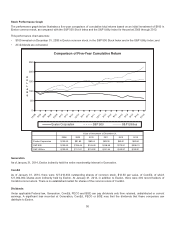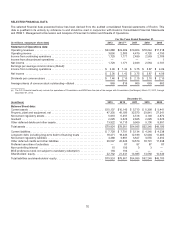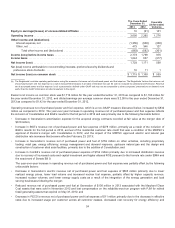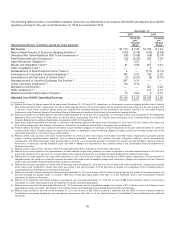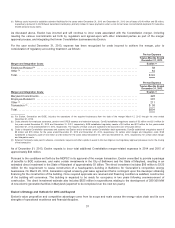ComEd 2013 Annual Report Download - page 44
Download and view the complete annual report
Please find page 44 of the 2013 ComEd annual report below. You can navigate through the pages in the report by either clicking on the pages listed below, or by using the keyword search tool below to find specific information within the annual report.OnMarch 12,2012,theExelon andConstellation merger wascompleted. Themerger createsincremental strategic value by
matchingExelon’s clean generation fleet withConstellation’s leadingcustomer-facingplatform, aswell ascreatingeconomiesof
scale through expansion across the energy value chain.Exelon supportscustomer switchingto alternative electric generation
suppliersandtheaddition ofConstellation’s competitive retail operationsprovidesanother outlet for Exelon to growitsbusiness in
competitivemarkets.
Generation’s electricitygeneration strategy is to pursue opportunitiesthat providegeneration to loadmatchingandthat diversify the
generation fleet by expandingGeneration’s regional andtechnological footprint.Generation leveragesitsenergy generation portfolio
to ensure deliveryofenergy to bothwholesale andretailcustomersunder long-termandshort-termcontracts, andinwholesale
power markets. Generation’s customer facingactivitiesfoster development anddeliveryofother innovative energy-relatedproducts
andservicesfor itscustomers. Generation operatesinwell-developedenergy marketsandemploys an integratedhedgingstrategy
to managecommoditypricevolatility. Itsgeneration fleet,includingitsnuclear plants which consistentlyoperate at high capacity
factors, also providegeographic andsupplysourcediversity. Thesefactorshelp mitigate thecurrent challengingconditionsin
competitive energy markets.
Exelon’s utilitystrategy is to improve reliabilityandoperationsandenhancethecustomer experience, while ensuringratemaking
mechanisms providetheutilitiesfairfinancial returns. Exelon seeks to leverageitsscale andexpertiseacross theutilitiesplatform
through enhancedstandardization andsharingofbest practicesto achieveimprovedoperational andfinancial results. Combined,
theutilitiesplan to invest approximately$15billion over thenextfiveyearsinsmart meter technology, transmission projects, gas
infrastructure,andelectric systemimprovement projects, providinggreater reliabilityandimprovedservicefor our customersanda
stable return for thecompany.
Exelon’s financial prioritiesare to maintaininvestment gradecreditmetrics at each ofExelon,Generation,ComEd, PECO and BGE,
andto return value to Exelon’s shareholderswithasustainable dividendthroughout the energy commoditymarket cycle andthrough
earnings growthfromattractiveinvestment opportunities.
In pursuingitsstrategies, Exelon hasexposure to variousmarket andfinancial risks, includingtherisk ofpricefluctuationsinthe
power markets. Power pricesare a function ofsupplyanddemand, which in turn are driven by factorssuch as(1)thepriceoffuels,
in particular,thepricesofnatural gasandcoal, which drivethemarket pricesthat Generation can obtainfor the output ofitspower
plants, (2)the rate ofexpansion ofsubsidizedlow-carbon generation inthemarketsinwhich Generation’s output is sold, (3)the
effectson energy demanddue to factorssuch asweather,economic conditionsandimplementation ofenergy efficiency and
demandresponse programs, and (4) theimpactsofincreasedcompetition inthe retailchannel.Exelon continuesto assess
infrastructure,operational,commercial,policy, andlegal solutionsto thesemarket pricing issues.
Power Markets
Price of Fuels. Theuseofnewtechnologiesto recover natural gasfromshale depositsisincreasingnatural gassupplyand
reserves, which placesdownwardpressure on natural gaspricesand, therefore,on wholesale andretailpower prices, which results
inareduction inExelon’s revenues. Sincethethirdquarter of2011,forwardnatural gaspricesfor 2014and2015havedeclined
significantly; in part reflectingan increaseinsupplydue to strongnatural gasproduction (due to shale gasdevelopment).
Subsidized Generation. The rate ofexpansion ofsubsidizedlow-carbon generation such aswindandsolar energy inthemarkets
inwhich Generation’s output is soldcan negativelyimpactwholesale power prices, andin turn,Generation’s resultsofoperations.
Variousstateshaveimplementedor proposedlegislation,regulationsor other policiesto subsidizenewgeneration development,
which mayresult in artificiallydepressedwholesale energy andcapacityprices. For example,theNewJerseylegislature enacted
into lawinJanuary2011,theLongTermcapacityPilot Program (LCAPP). LCAPP provideseligible generatorswith15-year fixed
contractsfor thesale ofcapacityinthePJM capacitymarket.Under LCAPP, thelocal utilitiesinNewJerseyare requiredto pay(or
receive)thedifferencebetween generatorsreceiveinthecapacitymarket andthepriceguaranteedunder the15year contract.New
Jerseyultimatelyselectedthree proposalsto participate inLCAPP andbuildnewgeneration inthestate.Inaddition,on April12,
2012,theMDPSC issuedan order directingtheMarylandelectric utilitiesto enter into a 20-year contractfor differences (CfD) with
CPV Maryland, LLC (CPV), under which CPV will construct an approximately700 MW combined cycle gasturbine inWaldorf,
Maryland, that it projectedwill beincommercial operation by June 1,2015. CPV hassubsequentlysoughttoextendthat date.The
CfD mandatesthat utilities(including BGE) pay(or receive)thedifferencebetween CPV’s contractpriceandtherevenuesitreceives
for capacityandenergy fromclearingtheunitinthePJM capacitymarket.
38




